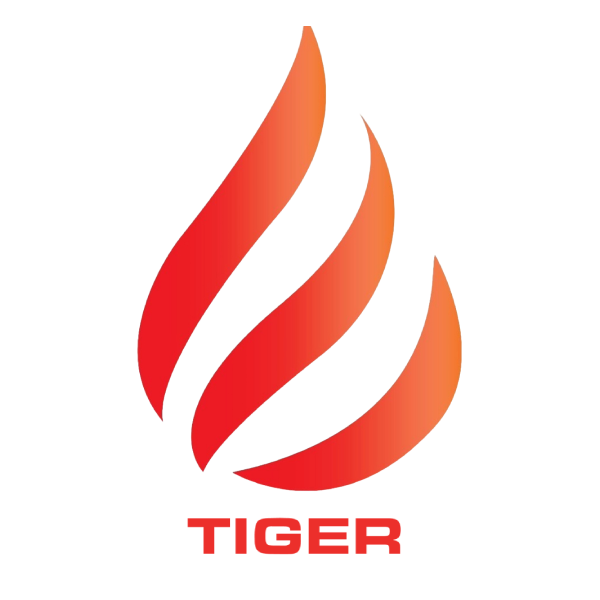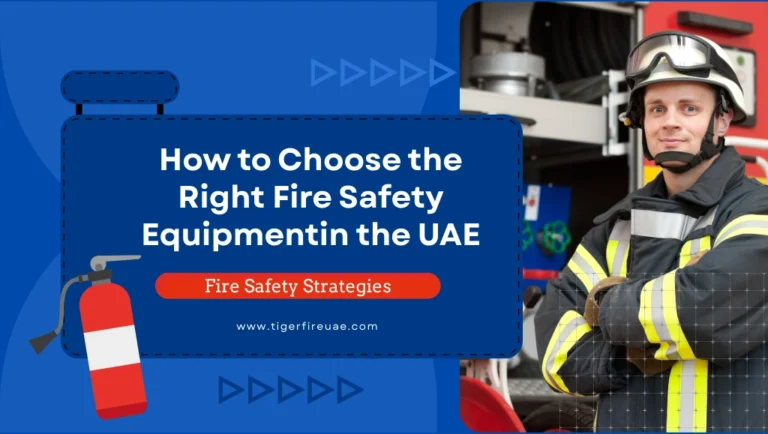In the UAE’s rapidly growing urban landscape, having the right fire safety equipment isn’t just a recommendation—it’s a legal requirement. The UAE Civil Defence mandates strict compliancewith fire safety standards, and businesses that fail to meet these regulations face heavy fines or even closure.
Choosing the correct fire safety equipment in UAE involves understanding:
✔ Your specific business risks
✔ UAE fire safety regulations
✔ Different types of fire protection systems
✔ Proper installation and maintenance
This guide will walk you through everything you need to know to make informed decisions about fire safety equipment for your home or business.
1. Understanding UAE Fire Safety Regulations
1.1 Legal Requirements for Businesses
All businesses in the UAE must comply with fire safety rules to operate legally. This includes using certified equipment and passing regular inspections. Violations lead to serious fines and risk to life. Meeting these standards is non-negotiable for workplace safety.
● The UAE Civil Defence requires all commercial establishments to have:
● Fire extinguishers (properly placed and maintained)
● Smoke detectors and fire alarms
● Emergency lighting and exit signs
● Fire blankets in kitchens
● Regular fire safety training for staff
Penalties for Non-Compliance: Fines up to AED 50,000 and potential business suspension.
1.2 Industry-Specific Fire Safety Standards
Different industries face different types of fire risks. Hotels, factories, and kitchens all need tailored protection systems. The UAE mandates industry-specific safety standards for better risk control. Understanding your sector’s needs is key to proper fire preparedness.
Different industries have unique requirements:
● Hotels & High-Rise Buildings: Advanced sprinkler systems and smoke control
● Restaurants: Wet chemical extinguishers for grease fires
● Warehouses & Factories: Industrial-grade suppression systems
● Offices: Smoke detectors and fire extinguishers on every floor
1.3 Certification & Approval
Not all fire safety products are legally approved for use. Only equipment certified by UAE Civil Defence should be installed. International approvals add an extra layer of trust and quality. Always check for proper certification before making a purchase.
Always look for:
- UAE Civil Defence approval
- International certifications (NFPA, EN3, UL)
- Supplier with local service support
2. Types of Fire Safety Equipment in UAE & Their Uses
The UAE market offers a wide range of fire safety tools. From extinguishers to alarm systems, each serves a different function. Your building’s risk and layout determine what’s needed. Choosing the right equipment helps prevent and control fires effectively.
2.1 Fire Extinguishers: Choosing the Right Class
Using the wrong extinguisher can make a fire worse. Different classes are designed for electrical, flammable liquid, or grease fires. The right extinguisher can stop a fire in seconds. Understanding fire classes is crucial for safety.
Tip: Every 200 sqm in commercial spaces must have at least one extinguisher.
2.2 Fire Detection & Alarm Systems
Early warning systems reduce damage and save lives. Smoke detectors, heat sensors, and alarms work together to alert occupants. Each building type requires specific configurations. A reliable alarm system is a fire safety essential.
● Smoke Detectors (Ionization vs. Photoelectric)
● Heat Detectors (Fixed vs. Rate-of-Rise)
● Manual Call Points (Break-glass units)
● Voice Evacuation Systems (For large buildings)
Smart Option: IoT-enabled alarms that send alerts to your phone.
2.3 Emergency Fire Safety Gear
In emergencies, accessibility to gear can save lives. Items like blankets, signs, and hoses play supporting roles in firefighting. These should be well-placed, visible, and regularly checked. Emergency gear complements larger systems during a fire.
- Fire Blankets (For small fires or wrapping around a person)
- Emergency Exit Signs (Glow-in-the-dark, battery-backed)
- Fire Hose Reels (Mandatory in high-rises)
- First Aid Fire Kits (For immediate response)
3. How to Select the Best Fire Safety Equipment for Your Needs
Every building has unique fire safety requirements. Selection depends on layout, risk level, and occupancy. A tailored approach ensures better protection and regulatory compliance. Let’s understand how to make informed decisions for your safety needs.
3.1 Assessing Your Fire Risks
Before choosing equipment, evaluate your fire risks carefully. Consider materials, operations, and foot traffic when assessing danger zones. A thorough risk assessment guides your protection strategy. It’s the foundation of an effective fire safety plan.
Conduct a fire risk assessment to determine:
✔ Potential fire hazards (electrical, chemical, kitchen)
✔ Building size and layout
✔ Number of occupants
✔ Special requirements (data centers, labs, etc.)
3.2 Choosing a Reliable Supplier
A good supplier offers more than just products. They ensure certifications, after-sales support, and regulatory alignment. Choosing quality over cost helps avoid future complications. Partner with a vendor who values safety and service.
Look for:
- Civil Defence-approved vendors
- After-sales service & maintenance
- Positive customer reviews
- Competitive pricing with warranty
Top Suppliers in UAE: NAFFCO, Honeywell, Eurotech, and local certified providers.
3.3 Installation & Maintenance Best Practices
Correct installation ensures equipment functions when needed most. Regular maintenance prevents malfunctions and keeps systems up to code. Staff must also be aware of how to use everything. Together, setup and upkeep form the backbone of safety.
- Professional installation (DIY setups often fail inspections)
- Monthly visual checks (Extinguishers, alarms)
- Annual professional servicing
- Staff training on proper usage
4. Budgeting for Fire Safety Equipment: Cost vs. Compliance
Fire safety technology is advancing rapidly across industries. From smart systems to sustainable suppressants, options are evolving. Adopting the latest trends improves efficiency and reduces risk. Stay updated to stay safe in a modern environment.
4.1 Price Ranges for Essential Equipment
Modern fire systems now include AI and mobile alerts. These features reduce false alarms and enable faster response times. Ideal for smart buildings, they bring convenience and safety together. Upgrade to smart solutions for a proactive approach.
- Fire extinguishers: AED 150–800 (depending on type and size)
- Smoke detectors: AED 100–500 per unit
- Full commercial alarm systems: AED 5,000–50,000+
4.2 Hidden Costs to Consider
Sustainability is entering the fire safety space. Clean agents and water-saving systems now meet both safety and environmental goals. These alternatives are effective and non-toxic. Go green without compromising on fire protection.
✔ Annual maintenance contracts (10–20% of equipment cost)
✔ Civil Defence certification fees
✔ Staff training programs
4.3 Cost-Saving Tips Without Compromising Safety
Heavy industries need more robust fire protection tools. Explosion-proof systems and automated responses handle extreme environments. These specialized tools are built to last and perform under pressure. Innovation is critical in high-risk workplaces.
- Bundle purchases with suppliers for discounts
- Opt for multi-purpose extinguishers (ABC class)
- Choose wireless systems to reduce installation costs
5. Step-by-Step Guide to Installing Fire Safety Equipment
Installing fire equipment isn’t just technical—it’s strategic. It involves pre-approvals, correct placements, and trained personnel. Each step ensures full compliance and operational readiness. Follow a structured plan to avoid setbacks and ensure safety.
5.1 Pre-Installation Checklist
Before starting, plan the layout and get official approvals. A site survey identifies the best spots for each item. Early preparation saves time and avoids errors. Never skip the checklist—it’s your roadmap to success.
- Obtain Civil Defence approval for plans
- Conduct site survey with certified technician
- Ensure proper spacing (extinguishers every 200 sqm)
5.2 Professional Installation Process
Trained technicians ensure compliance with all safety codes. They handle placement, spacing, and testing for each device. Avoid DIY methods, which risk non-compliance. Professional setup guarantees both function and legal approval.
- Positioning detectors/alarms (as per UAE fire code)
- Mounting extinguishers at 1.5m height for accessibility
- Testing all systems before handover
5.3 Post-Installation Verification
After installation, testing and staff training are a must. Documentation is reviewed by Civil Defence for final clearance. It’s the last step before full operational readiness. Post-install checks ensure everything is ready when it matters most.
- Mandatory Civil Defence inspection
- Documentation filing for compliance records
- Staff orientation session
6. Common Mistakes to Avoid When Choosing Fire Safety Equipment
Even small errors in planning or equipment choice can be costly. Many businesses make common mistakes that risk lives and compliance. Knowing these pitfalls can help you avoid them. Let’s focus on what not to do and how to fix it.
6.1 Top Errors Businesses Make
Buying the wrong gear or poor placement is a common error. Skipping training or ignoring maintenance also puts everyone at risk. These mistakes often stem from a lack of knowledge. Prevention starts with understanding what to avoid.
❌ Selecting undersized extinguishers for their risk
❌ Ignoring maintenance until annual inspection
❌ Placing equipment in inaccessible locations
6.2 How to Correct Existing Issues
- Schedule immediate audit if equipment is >5 years old
- Replace any non-compliant items (check Civil Defence circulars)
- Retrain staff on proper usage protocols
7. Creating a Culture of Fire Safety in Your Organization
Fire safety should be everyone’s responsibility, not just management’s. Building a culture of awareness leads to better preparedness. It requires consistent communication and leadership. A safe mindset makes your workplace resilient.
7.1 Employee Training Programs
Well-trained staff can prevent or respond to fires effectively. Custom training programs suit different departments and shift types. Regular drills reinforce quick response habits. Education is your first defense in an emergency.
- Quarterly fire drills with real-equipment practice
- Multilingual training materials for diverse workforces
- Designate floor wardens for emergency coordination
7.2 Maintenance Accountability Systems
Without tracking, maintenance often gets overlooked. Digital systems help schedule checks and alert you to service needs. Assigning responsibility ensures nothing falls through the cracks. Accountability turns planning into action.
- Digital tracking of inspection dates
- QR code tags for instant equipment info access
- Reward systems for safety-conscious staff
Conclusion:
Investing in the right fire safety equipment is vital for long-term protection. It’s not just about buying tools—it’s about building a strategy. From planning to maintenance, every step matters. Act today to protect what matters tomorrow.
By implementing these strategies, you’ll:
✔ Achieve 100% compliance with UAE regulations
✔ Reduce insurance premiums by 15–30%
✔ Gain competitive advantage as a safety-conscious business

